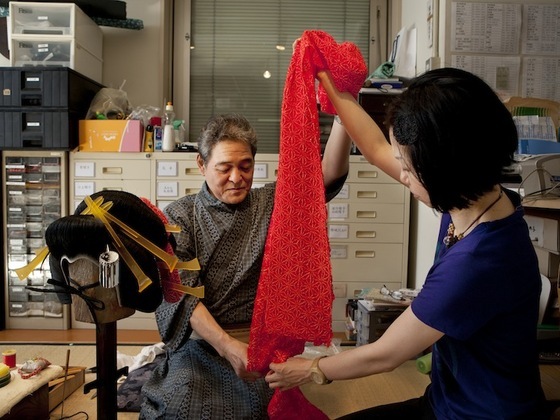
Did you know that the presence of Kabuki, one of the most famous traditional performing arts in Japan, is at risk? It’s NOT because they suffer from a lack of performers – it’s because they are running out of stage tools.
With society changing, many of these stage tools now rely on the hands of just one craftsman each. If this one craftsman dies, the stage tool will also die. And eventually, Kabuki may die out as well.

To help protect these stage tools, one lady stood up and took action. Ms. Tamiko Tamura, a freelance journalist, heard from many of her interviewees about the serious situation of Kabuki. To make matters worse, no one knew how to solve this problem.
That’s when Ms. Tamura decided to establish “DO-GU LABO for Japanese Traditional Performing Arts.”

What made her take this big step?
The art of Kabuki lies in all of its components. Even if the actor performs well, if he doesn’t have the best stage tools, the performance wouldn’t be as good. This is why I find it so important to restore the stage tools of Kabuki – I’d like it to be passed on at its best.
Since I’m a writer, I’m used to contacting people all over Japan. I also know Kabuki and the people working backstage. So then I thought, why don’t I give it a try?
Ms. Tamura herself learns Nogaku Theatre. As she researched more about Noh, she found out that it also faces the same problems as Kabuki. Right now, at “DO-GU LABO”, Ms. Tamura works to preserve the stage tools that are used in Kabuki and Nogaku Theatre.
How does “DO-GU LABO” Help Out?

Ms. Tamura’s “DO-GU LABO” tries to save stage tools through the following:
1. Creating a “Red List of Endangered Stage Tools of Traditional Performing Arts”
By creating a “Red List”, we can tell which tools are under the most risk.
2. Developing a New Production Route
For example, the kanoko* is necessary for the tokoyama** to make Kabuki wigs. Since kanoko is used to make kimonos, the technique was still there. But, the kanoko used for the Kabuki wigs need to be thin. Sadly, no one is now able to make this type of kanoko.
This is when Ms. Tamura came into play. She searched for craftsmen who had knowledge on traditional textile dying, and went back and forth communicating between the tokoyama and the craftsmen. As a result, she recovered the kanoko after one year.
3. Recruiting Craftsmen
Ms. Tamura posts up recruiting information and helps search for successors, so that the best match can be made between the applicant and this specialised world of traditional craft.
4. Keeping Craftsmanship Alive
“DO-GU LABO” explains the current situation of stage tools through lectures and events, and also acts as the mediator between craftsmen and companies.
What should We Do to Save Traditional Performing Arts?
There are many actors trying to save Kabuki and Nogaku Theatre, but the situation still seems grave. Ms. Tamura told us that we should all work together, but each in our own way.
It depends on each actor. If you’re working as an individual, you can be more flexible and act quickly. As a public institution or a large organisation, it might be hard to provide quick assistance, but there are other benefits too.
Regardless of what kind of action you take, though, I think it’s very important for both the organisations and individuals to work together to achieve their common goal.
In hopes of recovering these stage tools, Ms. Tamura continues to spread the word. Her passion and clear vision to save tools give all of us hope in the world of traditional performing arts: there is definitely light at the end of the tunnel, and Ms. Tamura helps us see that, one step at a time.
*Kanoko: A type of accessory used to put on the Kabuki actor’s wig.
**Tokoyama: People who tie up the hair of the Kabuki actor’s wig.
[via Greenz.jp written by Felix Sayaka]
[English Text by Mai Iida]
NEXT ACTION
Paint your day with beautiful colors – “KARAFURU”
http://greenzglobal.jp/karafuru-1358.html

